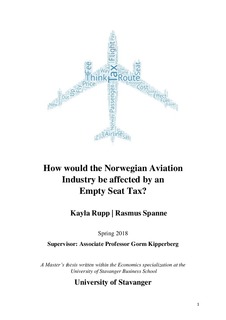| dc.contributor.advisor | Kipperberg, Gorm | |
| dc.contributor.author | Rupp, Kayla | |
| dc.contributor.author | Spanne, Rasmus | |
| dc.date.accessioned | 2018-09-24T11:37:16Z | |
| dc.date.available | 2018-09-24T11:37:16Z | |
| dc.date.issued | 2018-06 | |
| dc.identifier.uri | http://hdl.handle.net/11250/2564106 | |
| dc.description | Master's thesis in Economics | nb_NO |
| dc.description.abstract | The goal of this thesis is to explore the short- and long-term ramifications of various taxation regimes on the Norwegian aviation industry. The bulk of the research is focused on the probable effects of a tax placed on empty seats on commercial aircraft operating in Norway. This “empty seat tax” is contrasted in various ways with both the current taxation scheme, namely the flight passenger tax, and with other methods in which the Norwegian government could alter taxing the commercial aviation industry to combat CO2 emissions while keeping revenues constant.
A selection of previous research on the subject is presented through the themed lenses of environmental taxation, the economic implications of aviation taxes, elasticities of demand and supply, and green innovation in aviation. The authors developed an original microeconomic model for the empty seat tax, and use this and other theoretical foundations in order to gain a better understanding of various methods of taxation. An original flow chart model which illustrates the consequences of an empty seat tax for airlines, other industry stakeholders, the market equilibrium for air travel, and the wider society follows.
The analysis is based on a series of semi-structured interviews with various experts linked to the Norwegian aviation industry, in both the public and private sectors. Word clouds were used as a tool to facilitate analysis of these interviews, alongside additional comparisons categorized by respondent group in order to elucidate different points of view. The results are discussed through the themed lenses approach developed by the authors, and linked back to the theoretical foundations of the thesis. Overall, the authors find that neither the empty seat tax nor the current taxation regime is the most efficient or ideal, and recommend instead a distance-based tax on kilometers flown or a simple root tax on jet fuel burned, both of which are better aligned with the environmental motivation underlying aviation taxation and fairer to airlines operating with different business models. | nb_NO |
| dc.language.iso | eng | nb_NO |
| dc.publisher | University of Stavanger, Norway | nb_NO |
| dc.relation.ispartofseries | Masteroppgave/UIS-HH/2018; | |
| dc.rights | Navngivelse 4.0 Internasjonal | * |
| dc.rights | Navngivelse 4.0 Internasjonal | * |
| dc.rights.uri | http://creativecommons.org/licenses/by/4.0/deed.no | * |
| dc.subject | økonomi | nb_NO |
| dc.subject | administrasjon | nb_NO |
| dc.subject | økonomisk analyse | nb_NO |
| dc.subject | air passenger tax | nb_NO |
| dc.subject | flypassasjeravgift | nb_NO |
| dc.subject | Norwegian aviation | nb_NO |
| dc.title | How would the Norwegian Aviation Industry be affected by an Empty Seat Tax? | nb_NO |
| dc.type | Master thesis | nb_NO |
| dc.subject.nsi | VDP::Social science: 200::Economics: 210::Business: 213 | nb_NO |

